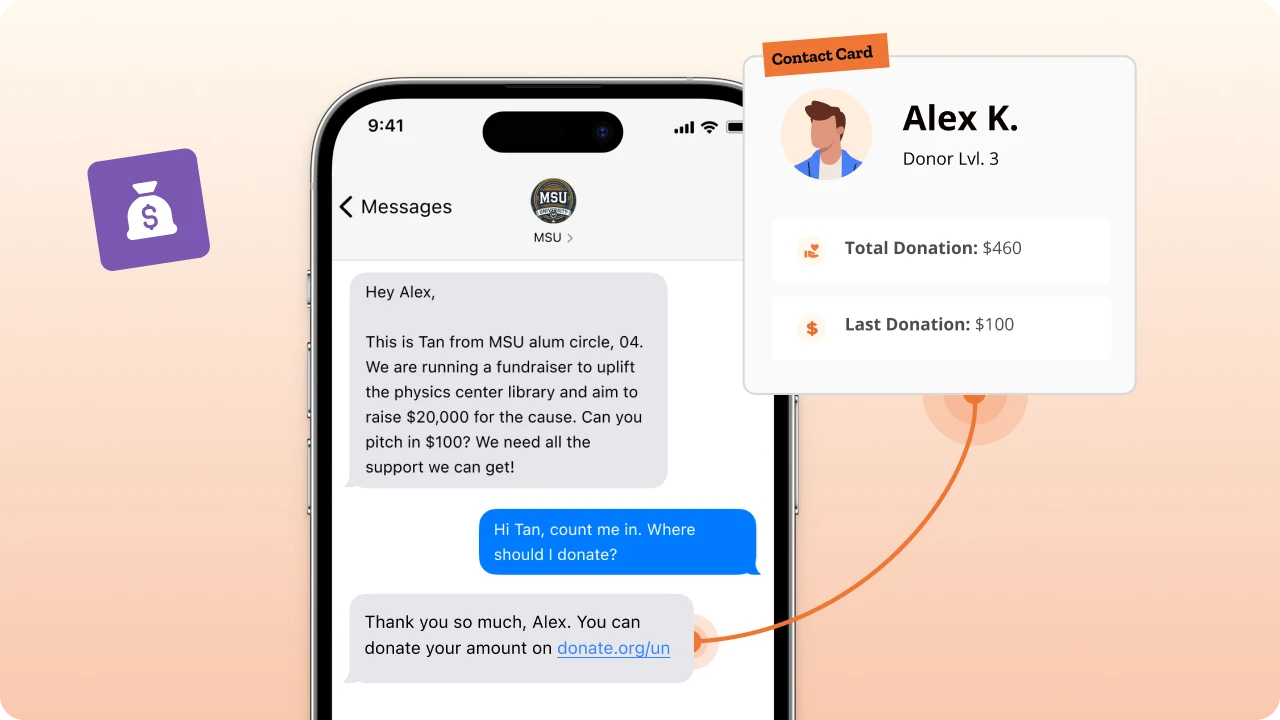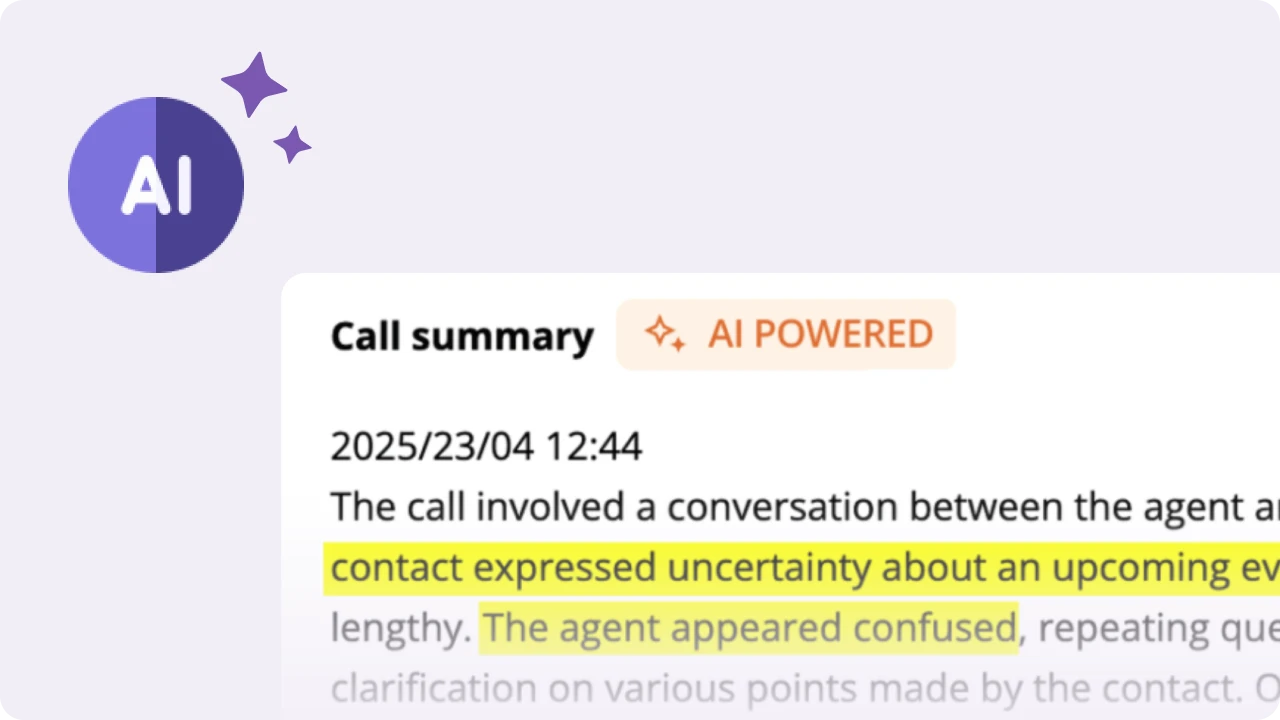Table of Contents
Giving Tuesday email examples are crucial for nonprofits aiming to capitalize on a must-win fundraising opportunity and to ensure your Giving Tuesday campaign stand out in a crowded inbox.. In 2024, donors gave $3.6 billion across the US, a record-breaking 16% year-over-year increase, most of it influenced by digital campaigns.
To win in 2025, you need expertly structured Giving Tuesday email examples, optimized for search and supporters. And I’m here to help you with just that, showing proven strategies, real templates, and fresh data so your Giving Tuesday email strategy gets noticed, opened, and funded.
What you’ll find in this guide:
- 6 proven Giving Tuesday email templates and subject lines
- Research-backed best practices for higher donation and open rates
- Tips for testing, tracking, and multi-channel engagement with CallHub.
Giving Tuesday email examples & campaign timeline
Here’s a simple six-step structure you can use to plan your Giving Tuesday 2025
| Email Type | Date | Focus | CTA |
| Announcement | 2 weeks out | Build anticipation, awareness | Add to calendar |
| Informational | 1 week out | Mission, impact, involvement | Social share |
| Reminder | Day before | Countdown, urgency | Forward to a friend |
| Appeal/Solicitation | Day-of | Donation ask, match gift, peer pressure | Donate now |
| Progress Update | Midday | Goal updates, social proof | Help us reach our goal |
| Thank You | Post-event | Gratitude, impact recap | Monthly gift invite |
Your Giving Tuesday campaign and email marketing cadence should build excitement from awareness to action to appreciation. The trick is to weave urgency and empathy into every step.
Top Giving Tuesday email examples & templates
Let’s look at a few Giving Tuesday email examples for email marketing from successful campaigns to inspire your Giving Tuesday email campaign.
1. The “Save the Date” announcement email
Subject line: “Mark your calendar, Giving Tuesday is December 2, 2025!”
The announcement email informs your existing and potential donors that you’re gearing up for Giving Tuesday and that you need their support. It’s also an ideal time to explain what Giving Tuesday is and why it matters – especially when tailoring outreach based on donor type, including new donors and returning supporters.
Research shows that only 18% of people are familiar with Giving Tuesday and its purpose. Educating your audience helps spark curiosity and early engagement.
Here’s an example:
A campaign by Charity: Water used a clean visual layout and minimal copy to announce the event while linking to their past year’s impact.
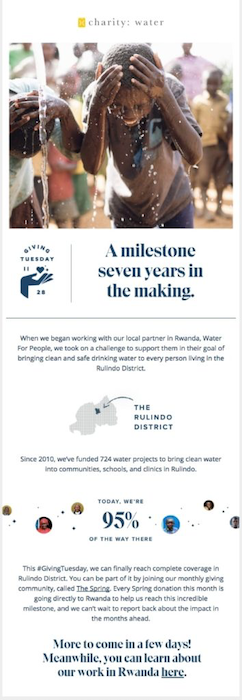
Source: Campaign Monitor
Takeaways from the email:
- Visual appeal: The design uses bold imagery and white space, guiding readers to the key message without clutter.
- Education first: Rather than leading with an ask, the email focuses on storytelling and awareness.
- Subtle CTA: A simple “Add to Calendar” or “Learn More” button sets up future engagement.
| Pro Tip: Use CallHub to schedule a follow-up SMS blast to reinforce your announcement and start building omnichannel awareness across email and social media. |
Read Also: Why Text Blast Marketing Gets Results: 78% know how!
2. The mission storytelling email – Giving Tuesday email examples
Subject line: “You Helped 500 Families Last Year. Let’s Do It Again!”
This email builds emotional connection by showcasing your mission’s real-world impact. Sent a week before Giving Tuesday, just as people are wrapping up Black Friday shopping. This helps shift attention back to generosity and community impact, acting as a multiple touchpoint in your donor journey.
Human connection drives donations. According to Stanford Graduate School of Business, a true donor story is up to 22 times more effective than statistics alone. Send this a week before Giving Tuesday to build emotional urgency, especially effective for first time donors.
Example:
An email from Feeding America paired a short story about a family supported by donations with a bold “Share Our Story” button.
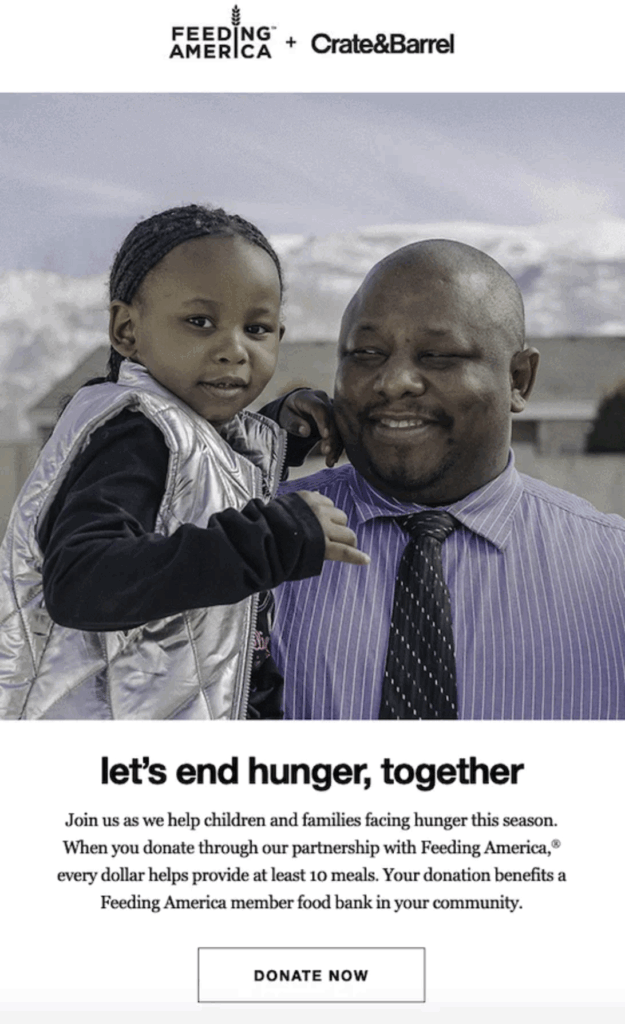
Source: Crate&Barrel
Best elements:
- Emotional storytelling: A short, true story creates a connection more quickly than statistics alone.
- Authentic imagery: Use real photos, not stock visuals, to drive empathy.
- Soft CTA: Encourage sharing, not just donating. This amplifies reach before the big day
| Callhub Tip: This is where personalized communication tools matter. Use automated segmentation to personalize messages for recurring, new, or lapsed donors. Integrate across email, text, and even voice calls. |
3. Beneficiary stories – Giving Tuesday email examples
Subject line: See How One Gift Changed a Life this Giving Tuesday”
In her study on fundraising, Deborah Small concluded that people are more likely to give if you appeal to their emotions with a story. Showcasing a story with a single relatable beneficiary works best.
In collaboration with Sears, St. Jude’s Children’s Hospital implements this well in their Giving Tuesday email showing how every gift can uplift a family or a small business connected to their community programs.
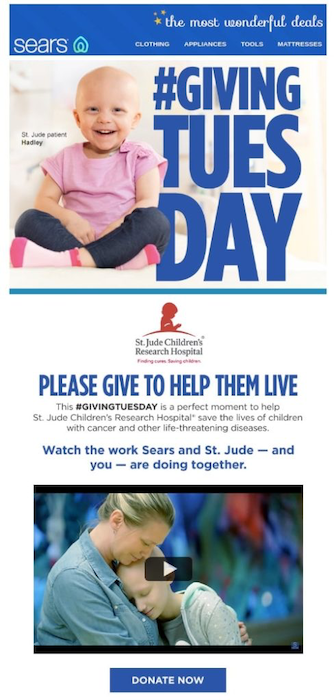
Source: Sendinblue
Takeaways from the email:
- Use video storytelling to create instant emotional connections and boost engagement rates.
- Keep copy minimal and direct attention to a single, memorable beneficiary story.
- Highlight corporate partnerships for credibility and increased campaign reach.
- Tailor your Giving Tuesday email examples for impact: focus on what one gift can accomplish and how it can double year impact.
Read Also: The perfect nonprofit storytelling approach to create effective messaging
4. Giving Tuesday reminder email examples
Subject line: “Tomorrow’s the Day! Are You In?”
This is your countdown moment. The reminder email builds urgency just before Giving Tuesday and keeps your campaign top of mind through well-timed follow-up.
Donors are already in a post-Small Business Saturday mindset of supporting meaningful causes, making this reminder email perfectly timed.
Remember why it’s important to give and how to give so they’re prepared at the right moment. Here’s an example of Coral Acres sending a simple reminder email about Giving Tuesday.

Source: DonorPerfect
Takeaways:
- Urgency done right: user countdowns and time-based visuals to drive FOMO, not pressure.
- Personal touch: Include a team member’s or volunteer’s name in the sign-off for authenticity.
- Multi-channel sync: Send a follow-up SMS reminder or automated voice broadcast for last-minute mudges, using CallHub’s multi-channel dashboard.
Read Also: Integrating SMS and Email Marketing for High Customer Reach
5. Solicitation email – Giving Tuesday email examples
Subject line: “We’re 72% There! Help Us Reach Our Goal!”
Finally, on Giving Tuesday, your focus is now on getting people to convert. A few elements that can give people the final push and inspire them to donate include:
- Inducing a sense of urgency
- Leveraging beneficiary stories
- A result-oriented approach
- Leveraging social pressure to get people to give
- Using a compelling subject line that encourages immediate action
Here’s a Giving Tuesday email example from the International Rescue Committee.
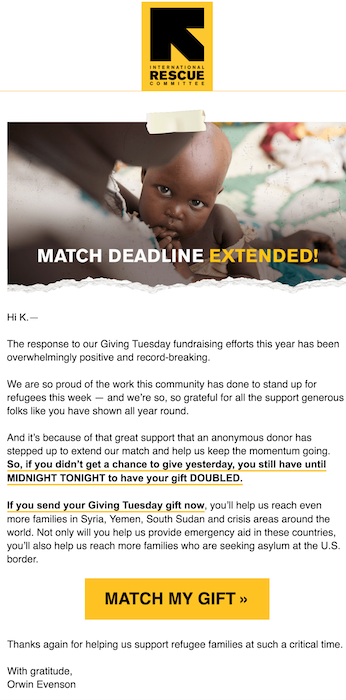
Takeaways from the email:
- Match motivation: Emails mentioning donation matches increase conversions by 71%.
- Strong CTA: Use a single button (“Donate Now”) and repeat it once at the bottom.
- Progress visuals: Show a bar or live counter for donations received.
Smart campaigners often pair this email with automated engagement tools that can re-target those who opened but didn’t donate, using platforms like CallHub to send a gentle reminder later in the day or reinforce urgency before midnight.
6. Thank you email
Subject line: “You Did It! Thank You for an Incredible Giving Tuesday!”
Thanking donors is the most important part of your campaign. Appreciating their support and making them feel valued is the first step to donor retention. You don’t want them to think that you don’t need them after their donation, because clearly, you do!
A good thank you email is:
- Simple but personalized
- Talks about the impact the donor made (or will be able to make)
Here’s an excellent Giving Tuesday thank-you email example from Bestwa

Takeaways from the email
- Personalized thank-you: This email is great because it addresses the receiver by name, includes a personal note, and has the signature of the organization’s director. These small elements make the email extremely personalized and more impactful in making the recipient feel appreciated.
- Highlight the impact: The email also talks about the amount raised and the number of people benefiting. Talking about the effect reinforces the importance of giving. Reminding people about that sets the foundation for future nurturing and repeat giving.
While these examples cover most tips and best practices, you must address a few more aspects to create impactful Giving Tuesday emails.
Read Next: Done With Giving Tuesday? Here Are Some Of The Best Ways To Thank Your Donors.
Giving Tuesday email examples: 2025 trends
Even the best message fails if it’s never opened.
- Use concise subject lines (9words or fewer) for higher open rates
- Test urgency, personalization, social proof, and gratitude angles
- Segment audiences and automate A/B tests with CallHub to optimize every message.
| Type | Example | Why it works |
| Urgency | “One day. One cause. One chance to give.” | Create Scarcity without pressure. |
| Personalization | “Sarah, your impact starts today.” | Builds an immediate connection |
| Community | “Join 36M people giving back this Tuesday.” | Adds social proof |
| Gratitude | “Because of you, 1,200 meals were served.” | Fosters trust |
| Match offer | “Double your donation, ends midnight!” | Drives action |
Pro tip: Test two versions per email. Even a 2-point lift in open rate can mean hundreds more donations and powerful learnings for your next campaign.
Giving Tuesday email examples checklist for 2025
Before launch, confirm your campaign meets modern standards:
- Segment audiences by donor history and interest.
- Optimize emails for mobile (over 40% open on phones).
- Use one clear CTA per message.
- Ensure compliance: GDPR (UK/EU), TCPA (US), CASL (Canada), Spam Act (Australia).
- Track opens, clicks, and conversions to refine next year’s plan.
Turn one day into a year-round impact
Giving Tuesday 2025 is your chance to spark generosity and strengthen community bonds. With clear storytelling and smart timing, you can make your campaign stand out, even in a crowded inbox.
Keep the momentum going beyond a single day by using CallHub to help you connect with donors through personalized email, text, and voice outreach from one simple platform built for nonprofits.
Giving Tuesday email examples: FAQs
What are some best practices to make the most of Giving Tuesday fundraising touchpoints?
Best practices for Giving Tuesday fundraising touchpoints include starting with a soft launch on social media and text campaigns to build awareness, adding a clear call to action in every message, utilizing relevant hashtags, incorporating engaging images and videos, and choosing multi-channel software like CallHub that integrates calling, texting, and emailing to streamline communication.
How can I effectively announce and promote our Giving Tuesday campaign to prospects?
To effectively announce and promote your Giving Tuesday campaign, use scheduled messages across all channels like emails, texts, social media, and phone calls, emphasizing your fundraising goal, sharing compelling impact stories, and including a strong call to action to encourage participation.
What are the key elements of a successful Giving Tuesday fundraising script?
A successful Giving Tuesday fundraising script generally includes an introductory greeting, providing context about the campaign, making a clear ask for support, and concluding with gratitude, ensuring the message remains uniform across channels and includes a specific call to action.
Why is consistency important in Giving Tuesday scripts across different channels?
Consistency in Giving Tuesday scripts across channels is essential because it ensures that every touchpoint reinforces the same message and call to action, which helps in building trust, reducing confusion, and increasing the likelihood of donations from supporters.
What should I do after Giving Tuesday to engage donors and acknowledge their support?
After Giving Tuesday, send thank you emails or calls expressing appreciation, share the total funds raised and the impact achieved, and maintain engagement by updating supporters on how their contributions are making a difference, which encourages ongoing support and loyalty.

